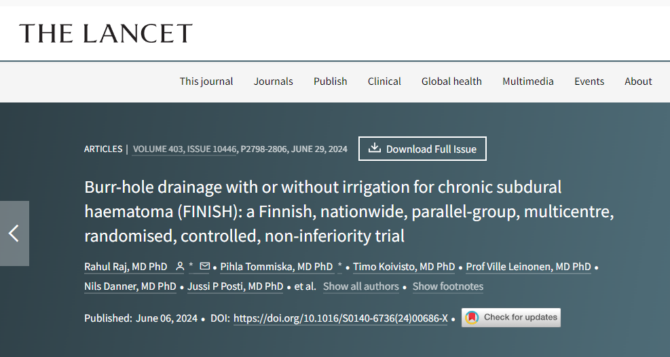FICEBO: We’re thrilled to announce that our FINISH trial results have been published in The Lancet! It’s a huge milestone for our team. We’ve gathered some of the key contributors to discuss their journey. Let’s dive into the details.

Q: How did the idea for the FINISH trial come about?
Kimmo: The idea stemmed from a long-standing question in neurosurgery. Burr-hole drainage is a common procedure for treating chronic subdural hematoma, but we realized that the effectiveness of the irrigation step in this procedure hadn’t been rigorously tested. We wanted to fill this gap in knowledge.
Q: What was the most challenging moment during the trial?
Rahul: Coordinating across all five neurosurgical units in Finland was quite a task. Each unit had its own processes and schedules, and aligning them required a lot of effort, especially as the trial started during the early phases of the Covid19 pandemic. However, the collaboration and commitment from everyone involved made it possible.
Q: What were the main findings of your study?
Pihla: We found that patients who didn’t receive irrigation during burr-hole drainage had a 6.0% higher need for reoperations compared to those who did (18.3% vs. 12.6%, difference 6.0% when stratified for study site). Interestingly, the neurological outcomes and mortality rates were similar between both groups. This underscores the importance of irrigation in reducing reoperation rates.
Q: How was your experience working with The Lancet?
Rahul: Publishing in The Lancet was a rigorous process, but immensely rewarding. The peer review was thorough, and it helped us refine our findings and ensure that our study met the highest standards of scientific excellence. We’re grateful for the feedback and support we received throughout.

Photo: Hanna Raijas-Turva/HUS
Q: Any final thoughts or acknowledgments?
Rahul, Pihla and Kimmo: We couldn’t have done this without the participation of all five Finnish neurosurgical units, the dedication of physicians, nurses, and researchers, and most importantly, the patients and their families. Their cooperation was crucial for the success of this trial. We hope our findings will improve treatment decisions for chronic subdural hematoma worldwide. For more details on our trial, please visit the FINISH project page.
